where to go ? any ideas ?
1234
1234
|
Hi, Im on this site to look for information to help my friend who is very sensitive. She can no longer live in her home, as the neighbour has an unbelievable amount of solar panels all over his roof and along his fence . She is in Western Australia and is renting out her house while she is renting a friends house temporarily in Esperance. Is anyone on this forum in Australia and have any idea where would be a safer place to live ? i notice a lot of you talk about going to the country, but she has found all the farmer have satellite phones or are on the 5g. She needs somewhere to go , or she will have to just go on the road to investigate herself. Not so easy or safe. Has anyone any ideas ? She was told to try Adelaide as all the hills there may provide some protection.
|
|
Some people suspect that solar panels ( as well as LED-lamps and monitors ) emit unmeasurable, pretty unhealthy "longitudinal" fields.
If i remember it correctly this harmful emission is said to leave at a straight angle ( of 90 degrees ) from the surface of the panels ( on both sides ). Also straight behind a satellite disk for television strong longitudinal fields at a large distance have been reported by people who sensed or were aware of a sickening effect. Certainly the inverters ( that convert the DC power from the solar panels into high voltage AC that can be fed into the electrical grid ) create a lot of electromagnetic pollution, both directly ( in the air ) as by polluting the grid, producing "dirty electricity" . The latter can travel through the electricity wires into other houses and be transmitted from the wires and devices there into the space. It is technically possible but not easy to filter out the dirty electriciticy straight where it enters the house ( originating from neighbours for instance, especially from one with lots of solar panels ) or where it is created inside by switching mode powersupplies, LED- and CFL- lamps, dimmers, computers etc. . The common filters ( like Stetzers ) are a waste of money, and in fact may make the problem worse. To rent out the house and renting a place where one feels more at ease sounds certainly like a sensible approach. Hurry often leads to missteps, and also the world around us keeps on changing, so flexibility is often a good strategy. I doubt that 5G will be a problem in the countryside anytime soon, it would be too expensive. If farmers use salellite phones it looks like that even 3G has not been rolled out there. As long as one stays at some distance ( 50 feet or more ) from these smart farmers, one will be probably fine. In order to cope with the increasing levels of emfs, apart from trying to minimize exposure, one has to work on one's health as well, which will be a long road to follow, and although there are plenty of maps, one has to find his own. Nevertheless things like eating organic and detoxification in some manner appear to be usually part of this adventure. |
|
In reply to this post by lisa
Perhaps this man knows where your friend might find a refuge in Australia:
|
|
In reply to this post by lisa
Here's another Australian your friend might contact for safe places:
From: lisa [via ES] <ml+[hidden email]>
Sent: Wednesday, August 7, 2019 4:33 AM To: Fog Top <[hidden email]> Subject: [ES] where to go ? any ideas ? Hi, Im on this site to look for information to help my friend who is very sensitive. She can no longer live in her home, as the neighbour has an unbelievable amount of solar panels all over his roof and along his fence . She is in Western Australia and
is renting out her house while she is renting a friends house temporarily in Esperance. Is anyone on this forum in Australia and have any idea where would be a safer place to live ? i notice a lot of you talk about going to the country, but she has found
all the farmer have satellite phones or are on the 5g. She needs somewhere to go , or she will have to just go on the road to investigate herself. Not so easy or safe. Has anyone any ideas ? She was told to try Adelaide as all the hills there may provide
some protection.
If you reply to this email, your message will be added to the discussion below:
http://es-forum.com/where-to-go-any-ideas-tp4034304.html
|
|
In reply to this post by earthworm
Thank you , you have given me a lot of information. I don't know how technically minded she is, but im not sure that the filters you talk about would be available over here. that said, yes, she could consider changing things up in her home when her lease is up at the end of this month.
She's all over the organic and eating a level 1 diet from her time spent in west virginia 2 years ago where she was clued up by the folk that took her in there. we have both done the Annie Hopper program together. Me for MCS and her for ES as well as for pain management. I am doing amazing , she is able to tolerate wifi for 10 mins twice a day . she will get there but just be a little slower than my quick progress. As our communication is always limited, I have misunderstood her info re farmers, but she insists it is worst . Maybe that is just in W.A. and not other states . thanks again for your awesome amount of tech info, it will be very helpful for her to perhaps re-evaluate her options. |
|
In reply to this post by Fog Top
awesome, thanks . i will send these on to her.
|
|
In reply to this post by lisa
Hi Lisa,
Quite nice of you to help your friend :) Power line filters are definitely available in Australia: https://au.mouser.com/productdetail/delta-electronics/20dwgg5?qs=sGAEpiMZZMsSfb%252b288R8Fa2t3w6gJEYJO8mkefrir8qHzZmVMaeP9w== Electricians should be able to install them. I haven't found them very useful, though. |
|
Karl (and others interested), I just stumbled upon a new filter called the SineTamer.
I don't remember where I got the information from initially, but this seems to be a whole house filter developed for industrial and even military applications, but it is available for residential users also. It seems to have good reviews, and it should be available world wide, but you need an electrician to install it. Something perhaps worth looking into? You really want a whole house filter in a case where the neighbors are polluting the whole local grid. Although the RF radiation might still enter the home from other routes of course, but this could help in many situations if it is the local DE that is the cause of symptoms. Some testimonials: https://www.defiltersllc.com/customer-testimonials-and-real-results/ More info: http://www.harmonicsolutions-oilandgas.com/mitigation-products/sinetamer/ Brochure: http://www.harmonicsolutions-oilandgas.com/wp-content/uploads/2014/08/sinetamer-catalog-brochure-2012.pdf |
|
Casper, this is what they say in their spec-sheet:
EMI/RFI Noise Attenuation: 30dB Max. from 1kHz to 10MHz Capacitance:Up to 3.5 uF Max. I think that some Belkiin power strips claim >30 dB, but when I tested them they made no difference in noise on the AM radio. My gut feeling is that $1,200 is too much. If they have a no-questions-asked return policy, you could try it and let all of us know :) You have a lot of options at that price point. For example, you could buy four isolation transformers: http://www.antekinc.com/an-154115-1500va-115v-transformer/ ...and put them inside a 12" diameter, 1/4" thick steel pipe connected to a 6' deep grounding rod. That would give you 50 amps of capacity, which I think is enough to satisfy the building codes in most places. If your building code has a 20 amp minimum for each circuit, you could connect all of the 'dirty' appliances to one pair of transformers and all of the sensitive things (like bedroom lights) to the other pair (which would help to keep them separate). The catch is that some types of noise will go right through an isolation transformer. The easiest and cheapest way to test whether it will work for you (before spending the money) would require you to violate code, so an electrician probably won't do it for you. (Most of the time you won't use anywhere near 50 amps. So you could wire a much smaller and cheaper transformer in between your meter and your main breaker box - WITH AN APPROPRIATE FUSE - and test it with an AM radio, or just see if you felt better.) You can also build a lot of smaller filters for less than $100. The parts are not too expensive: https://www.digikey.com/product-detail/en/illinois-capacitor/105MMR250K/1572-1190-ND/5410542 Here is an article by a different manufacturer about the problems with off-the-shelf filters: https://docs.wixstatic.com/ugd/53be97_320fa114167346d2afe453637487e292.pdf (I'm not endorsing their products and I haven't used them.) From the article: "The absolute majority of EMI filters on the market are designed to meet EMC regulations. Equipment designers are encouraged to select the lowest-cost filter that attenuates EMI just enough to pass EMC requirements in the laboratory–anything more than that would be a waste of money since in the EMC laboratory environment a better filter won't improve the product's performance or add to product's value." Also from the article:  I've had much better luck filtering DC power: https://youtu.be/d8YSXtMFEe4 (I wasn't feeling well when I made that video, so I originally didn't post it, but it seems relevant here.) |
|
Thanks Karl. That's a great video! I didn't know capacitors were that effective. I always thought you needed to build an RC filter, and calculate all the values and all of that hocus pocus. I'm going to try your setup with the DC output on my laptop power brick, which is extremely noisy.
I guess I can just go on eBay and look for any large cap for that purpose? Here I found 2x 10000uF for under 2 Euros: https://www.ebay.com/itm/6-3-450V-10-10000uF-High-Frequency-Low-Impedance-Radial-Electrolytic-Capacitor/202704290759 Or would you recommend some other caps for this? I agree with the price of the SineTamer is really high. However I think it is not just a bank of caps and inductors, but as I understood it is some sort of active (electronic) filter. Not sure if that qualifies the price either though. Definitely would want to test it before I buy. The isolation transformers sound like a pretty good idea, but I think I could not handle it in my apartment, as there is too little space to hide the transformers far enough away, and no access to any grounding rods. I've noticed I'm quite sensitive to magnetic fields from such transformers (previous tests with linear DC power supplies have been a fail, because of the transformer fields). But that could work well if you live in a single home house. Like you, I've also tested those cheap in-line AC EMI filters. They seem to make no difference what so ever. The CleanSweep filter that was referenced in the PDF doc seems interesting. At least their graphs are impressive. I couldn't find a price on it anywhere on-line. They were all "call for quote", which means it's probably quite expensive too. This 2 EUR capacitor idea is more in my price range. |
|
In reply to this post by Karl
Sorry. I didn't notice you left the inductor in the circuit with the capacitor.
Ok. Now it makes more sense. How do I know which type of inductor to get and what sort of specs do I need? You said "a pair of 1mH RF indcutors". Are those connected in parallel? Also where can I buy those? I tried to look on eBay, but not sure what the correct search term needs to be. Is it called a "choke"? |
|
This post was updated on .
The type of inductor didn't matter as much as I was expecting. The ones in the video are these:
https://www.mouser.com/productdetail/jw-miller/2200ht-102-v-rc?qs=vHwXmp3ZSzbSLwSr5MNnyw%3D%3D They're connected in series with the fan - the plus-side current passes through one, and the negative-side current passes through the other. I've also used larger Bourns inductors: https://www.digikey.com/product-detail/en/bourns-inc/2324-H-RC/M8847-ND/775386 ...as well as these: https://www.ebay.com/itm/233033066308 (I found them by searching for "toroidal inductor.") All of those worked well for the fan, but none of them worked as well on the AC side of a switching 5V charger. Inductors as big as 8 mH performed about the same in both situations. I should test some small ones with the fan to find the minimum useful size, but I haven't done it yet. About your laptop power brick: The small Bourns toroids will probably get too hot. Even the larger ones (second link) are only rated to 2.4 amps. You can run two inductors in parallel to handle twice the current with half the inductance if you need to. If you run inductors on AC, they'll get hotter. I'd also cover them with electrical tape or heat-shrink insulation if the manufacturer doesn't list a maximum voltage. The little capacitors in the video were these (metallized film capacitors rather than electrolytic capacitors): https://www.mouser.com/ProductDetail/Panasonic/ECQ-UAAF224M?qs=sGAEpiMZZMu3dWSqd4Tl0P8JmQac6bjpnrc8j0jdlD4%3D Supposedly the reason they worked as well as the large ones is that they have lower internal resistance. https://en.wikipedia.org/wiki/Equivalent_series_resistance https://xtronics.com/wiki/Capacitors_and_ESR.html Their other advantage is that they won't explode if you reverse the + and - terminals. I haven't built RC filters. They seem to be common in low-current devices like ADSL filters. LC or RLC filters seem more common in high-current devices. You can compare them here: https://electronicbase.net/low-pass-filter-calculator/ http://sim.okawa-denshi.jp/en/RLCtool.php ...and you can use this to predict how much power the resistor in an RC, RLC or RL filter will consume: http://www.ohmslawcalculator.com/ohms-law-calculator |
|
In reply to this post by casper
It would be nice if someone makes an active filter that doesn't generate a lot of noise itself. I haven't tested any whole-house filters because I'm in roughly the same situation you're in.
You can reduce magnetic fields from small E-core transformers by mounting them in opposite orientations: https://www.youtube.com/watch?v=we_jQiRC6W0 I also use a Y-connector to keep the current in each of them close to equal, and I put them inside a steel pipe: 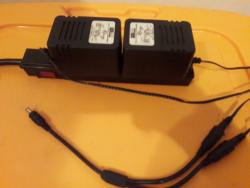 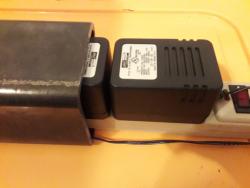 This is what they look like inside: 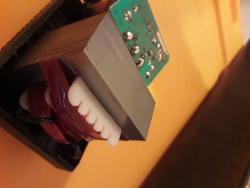 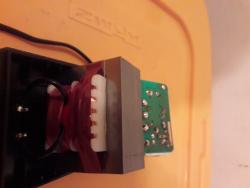 And even better solution would be to use a toroidal transformer: https://www.youtube.com/watch?v=NszhVvnBoE0 I put those inside a 4-inch steel pipe, or a steel electrical box: 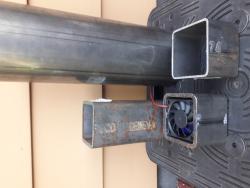 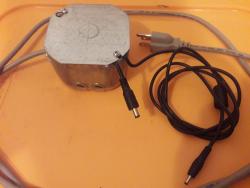
|
|
In reply to this post by Karl
Here are some pics of the larger Bourns inductor used in an AC LC filter:
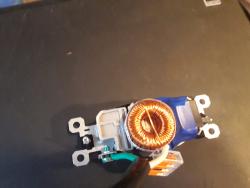 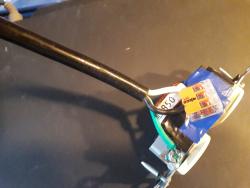 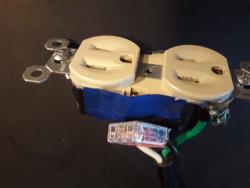 I added a fuse later: https://www.ebay.com/itm/273507122005 |
|
In reply to this post by Karl
Karl I want to say I really appreciate your replies. Your posts are extremely helpful. You gave me so many new ideas. I'm sorry I didn't reply earlier, but I was not feeling well and I have to wait to have the energy to type again.
You really have some nice McGyver-type solutions. Especially the steel pipes for the power supplies. Where can you find such pipes? Just your average hardware store? Anyway, after reading your posts I started looking more into filtering my laptop supply, and I found this page: http://ka7oei.blogspot.com/2014/08/completely-containing-switching-power.html That guy managed to completely eliminate his SMPS noise. His approach seem similar to yours; to filter and put stuff into steel boxes. What I did next was order two filters: For the AC side I ordered this: https://www.ebay.com/itm/10A-EMI-filter-Power-Purifier-Finished-board-AC0V-220V-DC0V-400V-40-100mm/253039768211 And for the DC side this one: https://www.ebay.com/itm/DC-Power-Filter-Board-Power-Amplifier-Car-Power-EMI-Interference-Suppression-5A/323505215668 I'm only thinking the chokes on the DC side might be too small. Perhaps I have to try and find suitable toroids for 5A (my supply is 18V 4.9A) and build another one myself, if this eBay setup is not good enough. If I manage to build something that works I will report here later. I have an AC line noise meter, and I find that my laptop supply is polluting the whole apartment. Without the supply the reading is 200mV noise, with the supply it goes up to 1000mV in the same socket, and 600-800mV in remote sockets. Hopefully the eBay AC filter will cut out must of that. Btw. the Bourns inductor you used on the AC socket, does that help with anything? Did you put any other components there? |
|
Most people here are coping with something similar, and I really appreciate how communicative and constructive you are :)
Also, that's a great link. I got the steel pipes at Discount Steel in Minneapolis. They also have a store in Texas: discountsteel.com I don't know where you are, so I'm not sure what to suggest. In the USA and Canada, https://www.metalsupermarkets.com/ might be a good resource. I haven't tried them yet, but they were recommended to me as a supplier that is sometimes willing to special-order electrical steel or grain-oriented electrical steel. The AC filter board you bought looks similar the Delta AC filters I tested, but it might have bigger inductors. (The ones in the picture are common-mode inductors.) I haven't disassembled any of the Delta filters yet, but they list similar components in their diagram: 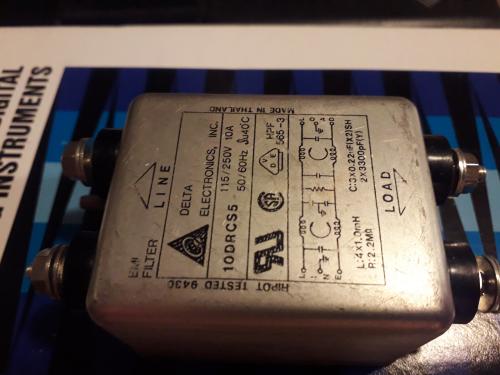 The yellow things on the boards you bought are the bigger capacitors that connect to both current carrying wires (and are usually labeled as "CX" in circuit diagrams) and the blue things are tiny capacitors that connect to the ground wire (usually labeled "CY"). Here is a picture on the inside of a simpler Canny Well filter: 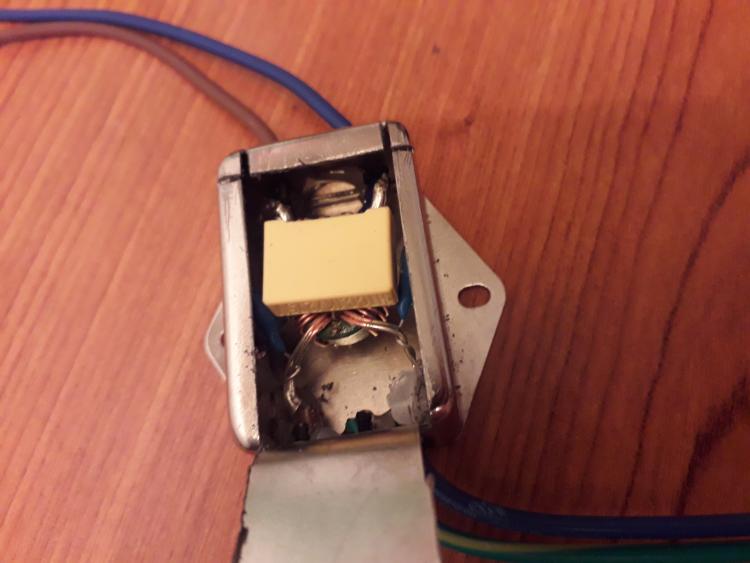 As for the DC filter, I don't know what the 220 on the inductors refers to, but maybe a 220 micro-Henry inductance value. I also don't have a good way to measure AC line noise, so I would really appreciate hearing what you find on the AC side. The Bourns inductor is paired with a 1 uF film capacitor. You can't see it because it's under electrical tape. Usually I install those modified outlets into a steel electrical box with a power cord to attach it to the wall outlet. You could also install one directly into the wall outlet box if you own the building. (It's very important to have the right fuse.) |
|
In reply to this post by casper
Casper, I forgot to answer one of your questions, and also forgot to mention one thing that might work for you.
- The AC filters built with the larger Bourns inductor made a modest difference in total noise when I tested them with some small switching power supplies and my neighbors' fluorescent plant-lights. In the case of the plant lights, they did a pretty good job of suppressing the high frequency noise, but seem to let some lower frequencies through. (I'm not sure exactly how much, since the circuit the lights are on is noisy to begin with :-/ ) - You could use a linear regulator instead of an LC filter on the DC side of your charger. The regulator boards I use are limited to 1.5A, but boards based on a regulator called the LT1083 should be able to handle up to 7A. This one might work: https://www.ebay.com/itm/Assembled-LT1083-Linear-Adjustable-Regulated-Power-Supply-Board-DC-DC-Max-15A/332666395070 (It doesn't have a heatsink, but it's designed to make it easy to mount a really big one for good cooling. And there are three separate regulators, so you can use the same board to supply 18V to your laptop and clean 5V to things like powered USB hubs.) This one might also work (with a big caveat*): www.ebay.com/itm/LT1083CP-Linear-Adjustable-Voltage-Buck-HIFI-Regulated-DC-Power-Supply-board/312734170711?hash=item48d068be57:g:d74AAOSwcOZb-MdC (*You don't need the rectifier, and you'll lose 1-2 volts as the DC current passes through it. You might be able to bypass it without any soldering by attaching alligator-clip-wires to two of the diodes. I can help you figure out which one, but it requires a better picture.) |
|
Ok thanks..that's pretty interesting. I didn't think about such a solution.
1) But won't the regulator require a voltage drop to work properly? The laptop needs 18V. I don't think it will work much under that voltage(?), although I have not tested what the limit might be. 2) Btw. I also have another question about the steel used in your pipes. Does it have to be some specific type of steel to shield EMF? You mentioned electrical steel. Is that essential, or are there some other steel/metals that can be used (I live in Finland, so I have to try and figure out where the local metal super markets are)? 3) The Bourns inductor on your AC outlet; I assume the inductor is connected in series, and the capacitor you put across live and neutral? Thinking about it..connecting the inductor any other way would probably create sparks, so I must be guessing right? :) |
|
This post was updated on .
Casper, you're right. I should have checked the voltage drop before recommending that board. (It's 1.3V at 7.5A, 1V at 3.5A and 0.95V at 1A.)
>> ...I have not tested what the limit might be. I don't know either, and it's difficult to figure out. Some chargers vary the output voltage: http://www.righto.com/2015/11/macbook-charger-teardown-surprising.html (From that link: "One reason the charger has more control components than a typical charger is its variable output voltage. To produce 60 watts, the charger provides 16.5 volts at 3.6 amps. For 85 watts, the voltage increases to 18.5 volts at 4.6 amps. This allows the charger to be compatible with lower-voltage 60 watt chargers, while still providing 85 watts for laptops that can use it.[13] As the current increases above 3.6 amps, the circuit gradually increases the output voltage. If the current increases too much, the charger abruptly shuts down around 90 watts.") USB type-C chargers with the "power delivery" feature do the same thing. If your laptop will run from any 18V power supply, then you could replace the charger entirely with a 100W toroidal transformer and a linear regulator. (A 50W transformer might also work if your laptop draws less than 4A in real use.) But that would be more expensive, and you may not have enough space to place the transformer far away from you. >> I also have another question about the steel used in your pipes. >> Does it have to be some specific type of steel to shield EMF? Not for the first layer of shielding around a transformer. Any kind will work there. But it needs to be thick (a few mm) to help measurably. Electrical steel is better when the field is already weak, because it aligns with outside magnetic fields more quickly. Usually it has more silicon and much less carbon, aluminum and sulphur than normal structural steels. These articles are about related materials with similar metallurgy: http://www.jfe-steel.co.jp/en/research/report/006/pdf/006-06.pdf https://www.horizontechnology.biz/blog/iron-powder-types-permeability >> (I live in Finland, so I have to try and figure out where the local metal super markets are) There seem to be a lot of good suppliers in Britain. I assume that there are others in the Continent. >> The Bourns inductor on your AC outlet; I assume the inductor is connected in series, >> and the capacitor you put across live and neutral? Yes, exactly. |
|
I forgot to mention something about using normal steel for shielding:
It should have the lowest possible carbon content. (That's usually what you receive if you buy cheap steel sheet, plate or pipe, so you might not need to worry about it.) I found this site with information on EU alloy numbering: http://www.steelnumber.com/en/number_en10027_eu.php In the US, ASTM 1008 is an OK alloy. |
«
Return to ES
|
1 view|%1 views
| Free forum by Nabble | Edit this page |



